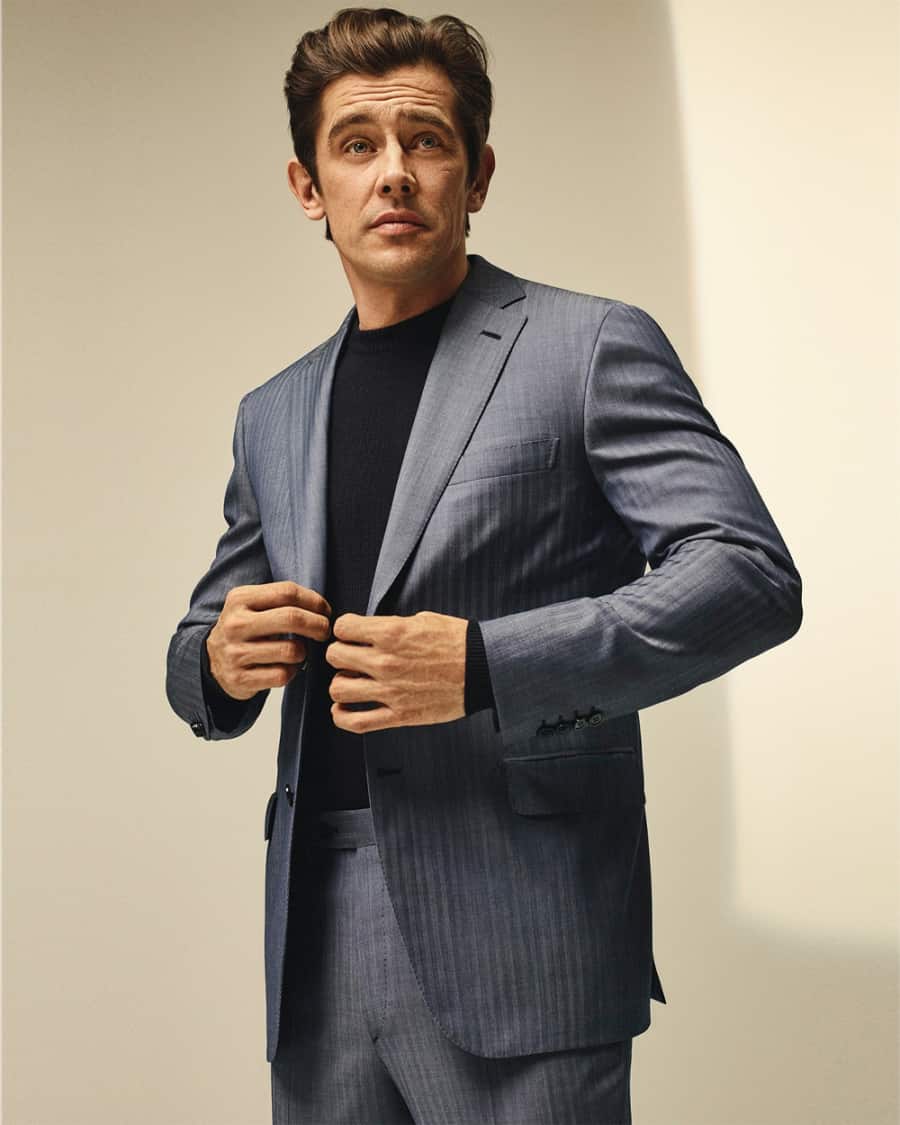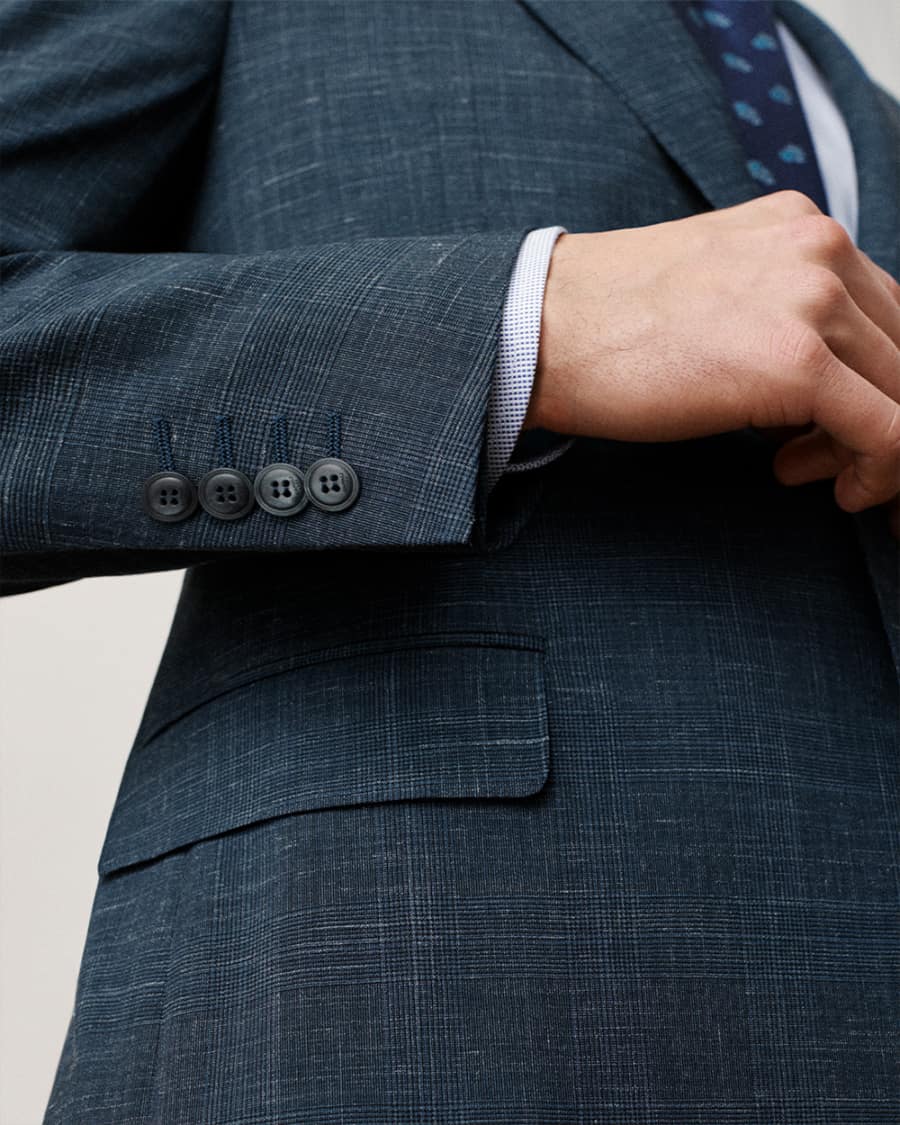
The Lounge Suit: A Modern Man’s Guide For 2024
Don't be confused, this is a two-piece business suit by another name. But its history is fascinating and its styling options infinite.
As mad as it might seem to us 21st-century types in our hoodies, track pants and sneakers, the suit as we know it today was once a very casual piece of clothing, being a relaxed and informal alternative to the gentleman’s frock coat. Hence, that’s why the ‘lounge’ moniker came into being, and is also why when anyone sees it as a dress code today, it provokes some level of confusion.
That we associate the modern suit with business is rather underplaying the diversity of the suit as a garment that really ticks all the style boxes, whether you wear it to work Monday to Friday or casually at the weekend. However, we’re seeing that bias change on the runways of Paris and Milan in recent seasons, where some of the biggest luxury houses are reinventing the suit as something much more fluid and modern – and not at all confined to the office.
The 2024 lounge suit
The lounge suit today is in a great place. Maybe even the best place, because wherever one looks, one can find a particular style of suit that looks elegant, fashionable, casual, smart… or all of those things at once.
The suit has wrestled free from the shackles of ‘business uniform’ to once again be a look that can be high-fashion on the one hand, or breezy casual on the other. Houses such as Saint Laurent continue with a slim cut, while others pursue a boxier trend-driven look.
Of the tailoring houses, choose your style and take your pick, with the British and Italian specialists all offering something slightly different. The internet has democratised style in many ways, so that there is no big movement towards one look or another, but rather many different and equally relevant tribes.
Key lounge suit fabrics
Wool lounge suits
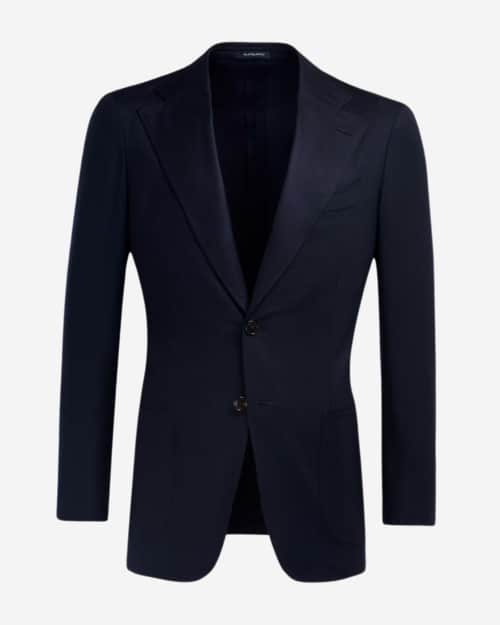

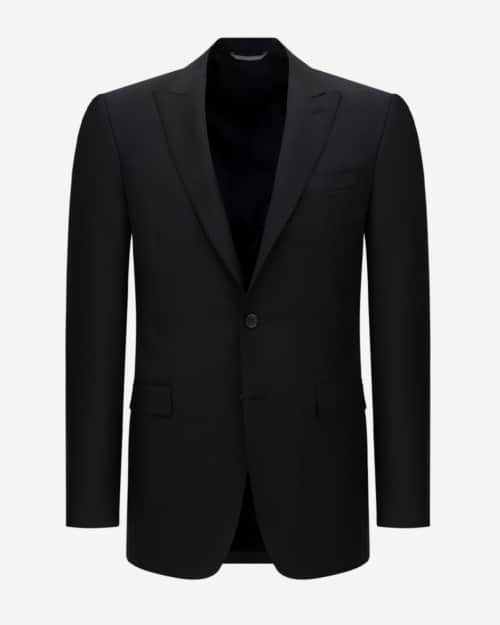
While there are lots of different types of wool, for the purposes of a lounge suit, you are almost always going to want a ‘worsted’ wool. Worsted refers to a high-quality yarn that is lightweight, smooth and very durable.
It takes its name from the English village of Worstead, in Norfolk, which was a hub for manufacturing in the 12th century. It was one of the first places where foreign breeds of sheep were raised, producing long wool fibres of great quality. Around the same time, England was experiencing a migration of Flemish textile weavers, most of whom gravitated to Worstead to work with the superior yarns.
These days, most good suits are constructed from merino wool, likely to have been farmed in Australia and New Zealand. The fine fibres make cloths that are lightweight, breathable, temperature regulating and soft yet strong. You’ll often see the cloths referred to by ‘Super’ numbers, which is just an industry measurement of the width of the fibres. The higher the number, the finer the fabric.
Any cloth from Super 100s to Super 250s is considered to be of high quality, but you need to think about how you’re going to wear the suit. If you can afford a Super 250s cloth suit then congratulations, but if you’re going to wear it everyday to work then you better stock up on spare pairs of trousers because you’re going to run through that superfine cloth in no time. A Super 120s cloth would be a much smarter way to spend less money.
Cotton lounge suits


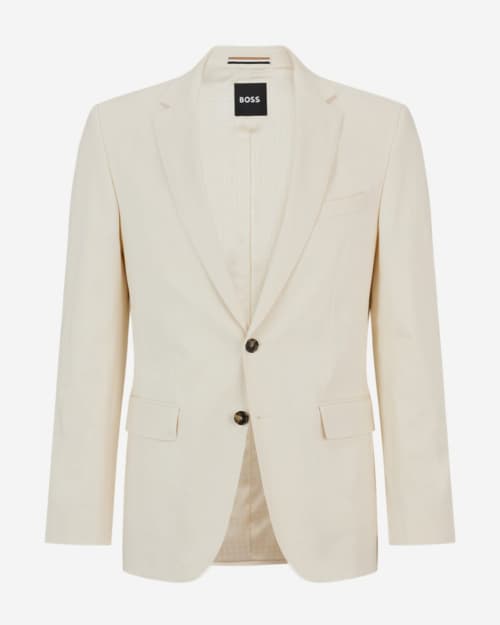
Cotton lounge suits are also an option, albeit far more relaxed given that cotton doesn’t have the weight to drape as naturally as worsted wool. Nevertheless it’s a great summer-weight cloth that can be dressed down with a polo shirt or dressed up with a smart shirt and tie.
If you want to wear a suit as an extension of your casualwear, then cotton is probably the way to go, and it’ll be that much easier to wear the suit as separates.
Linen lounge suits



Linen is another fantastic lounge suit fabric. Harvested from flax, it’s the most sustainable of the natural fibres since flax crops are naturally irrigated by rain water. The soft, lightweight slubby cloth takes dye really well, which is why you’ll find plenty of pastel tones available in linen in summer collections.
What are the key elements of the lounge suit?
Single-breasted jackets
The single-breasted jacket is the most popular style today and typically consists of a one-, two-, or three-button front fastening. In recent years, the three-button style has fallen out of favour because it naturally has a boxier shape than the other two varieties (it remains a good option if you’re really tall).
The two-button lounge suit is perfect for most situations, whereas the one-button lounge suit is a minimalistic style that has a slightly more formal edge.
Double-breasted jackets
Double-breasted jackets wrap at the front, creating a more formal and traditional look. Jackets can come in a number of button configurations – with four, six, or eight buttons on the front – but six is generally the standard, as are peak lapels.
Jacket lapels
Lapels are either notched or peaked, and should typically be as wide as the wearer’s face for the most flattering look.
Notch styles are the most popular, with peak lapels being slightly more formal (which is why you’ll never find notch lapels on a double-breasted jacket).
Jacket shape
The silhouette of the jacket is generally one of three styles:
- Sack, or unstructured, which is devoid of any padding or canvassing and drapes very naturally (favoured by Italian tailors);
- Structured, the most formal silhouette (often because it’s bespoke or made-to-measure) due to the padding and canvassing that literally creates a flattering structure with a trim waist;
- Fitted, which refers to a jacket that has a more accentuated waist and reduced padding for those with a good physique.
Jacket vents
Lounge suit jackets will have one of three vent configurations at the back: no vent, single vent or double-vent.
Italian tailors typically prefer the no-vent route whereas the English err on the side of the double-vent (which is probably a throwback from the days when gentlemen rode horses). The single-vent is the least preferred for the simple reason that it shows your backside.
Jacket lining
Unlined, half-lined and fully lined are your three options. Price will often play a part in what your jacket looks like on the inside. A full lining adds weight and structure so is a good idea when thinking about a smart business suit, although it can get hot in the summer.
An unlined jacket will, somewhat paradoxically, be more expensive since the tailor can’t hide his/her stitchwork behind a lining so it has to be good.
Jacket pockets
As a rule, the two front pockets of a single- or double-breasted jacket should be either flap pockets or jetted pockets, but never patch pockets. Flap pockets add a bit of extra width to the hip and can sometimes define the waist a bit better whereas jetted pockets create a smoother sleeker look.
Jetted pockets will always be straight whereas flap pockets can come angled for a slightly more sporty aesthetic.
Trouser styles
The sleek flat-fronted suit trouser is still the default style for business suiting since it provides a clean svelte silhouette, but both the single- and double-pleated trouser are excellent alternatives if you prefer a more sartorial look that is roomier around the hips. Pleats work exceptionally well with worsted wools since they are a dense cloth and hold the fold of the trouser nicely.
The flat-fronted style is typically worn without a cuff in the leg due to the smart clean aesthetic, whereas pleated styles are excellent with a cuff.
Leg length is a contentious debate, with many fashion houses choosing a shorter cropped style in recent years. If you’re wearing your lounge suit for business, then a trouser that rests on the top of your shoe and has a break in the shin is just right, whereas cropped styles are more fashion forward and should be worn as such.
In recent seasons, a much fuller trouser leg has been seen on the runways of Louis Vuitton et al. as a smarter answer to the loose oversized silhouettes of streetwear. Personally, we love the look as a means of wearing the suit in a smart casual context, but you probably won’t get away with it in a traditional office environment.
How to wear a lounge suit in 2024
Styling the lounge suit is a very subjective business and suffice to say everyone has their own take on it. The classic shirt and tie, despite what you might read, is still the de facto formal configuration and rarely fails to look sophisticated. If the intention is to look smart, then complementing the suit with a pair of polished Oxfords is perfect, but for something more flamboyant we’d highly recommend a pair of single or double monks in burnished calfskin, too.
For a more casual approach, swap in a pair of loafers and opt for a knitted merino wool or silk polo shirt with a soft-rolled or flat collar in the summer, or a fine-gauge crew neck or turtleneck knit in the winter. Keep the tones muted – navy, black and charcoal – for a chic aesthetic, or add in a bold splash of colour if you want to make more of a statement, such as for a cocktail attire dress code.
Next along the casual spectrum, is the plain tee and sneakers combination. Boxier suits with fuller legs are much better suited to wearing with sneakers than a more traditional fitted suit with tapered trousers. Take a look at recent collections by the likes of Louis Vuitton, Lemaire and Zegna for slick examples of adding that streetwear touch to loose, relaxed tailoring silhouettes.
The history of the lounge suit
To give you a detailed rundown of the history of the lounge suit would require an entire story all of its own. Instead, we’ll rattle through the most important parts so as to best understand how we’ve arrived at today’s iteration.
As mentioned above, the suit was born of casual origins, notably from Scotland in the 1850s when it was designed as rugged outdoor clothing made from hard-wearing woollen yarns such as tweed. That it had matching trousers actually made it casual since the smart attire at the time – frock coats and morning coats – were worn with contrast trousers. It was Beau Brummell who really catalysed the move away from pompous formalwear, with the frock coat giving way to the morning coat, and eventually the tail-less lounge suit.
The Victorians split into two sartorial camps: those who persisted with the relatively new morning coat, and those who favoured the shorter lounge suit. As the curtain closed on the 1800s, the door opened for the lounge suit, but it still clung onto some of the morning suit dimensions: the coat was tight-fitting and with a long skirt and short lapels, while the suit trousers were very fitted. It wasn’t until 1910 that a Danish tailor in Paris called Lars Larsen created the pleated trouser and pant dimensions began to loosen up.
1920s lounge suit

Men in the 1920s wearing lounge suits
Roll on the Edwardians in the 1910s who had by that time adopted the lounge suit, but it was still fairly unrefined, often made with heavy coarse yarns for practicality (coal-fired homes and filthy London streets were no places for fine fabrics). The Roaring 20s put a rocket up the suit’s evolution as the silhouette went from tightly fitted to a fuller shape, influenced by military uniforms.
The trousers and jacket were often quite short, but by the end of the decade a much more natural drape was created by applying more fabric to the chest of the jacket. The pants assumed a more relaxed shape too, with a straight-cut leg and a very high waist.
The dawn of the Jazz Age ushered in a new wave of lounge suit colours such as pastels, as well as flamboyant accessories such as silk pockets squares, tie pins, flashy cufflinks and of course, the double-breasted waistcoat, which no discerning gent would be seen without.
1930s-40s lounge suit

Clark Gable wearing a lounge suit in the 1940s
The 30s are often referred to as the ‘Golden Age’ of tailoring, when the suits were cut with a heavy elegant drape and the waists were narrow and the trousers high, full and handsome. The shoulders were typically wide, too, creating a very masculine aesthetic, made all the more so by Hollywood stars such as Clark Gable and Cary Grant.
In the 40s however, the suit became another entity altogether, mainly due to the World War and the rationing of materials. Hence the suit became more minimalistic and utilitarian with narrow lapels, trousers without cuffs and the waistcoat was firmly on the backburner.
As ever in tough times, a kernel of rebellion is often planted and on the menswear scene that kernel came in the shape of the zoot suit, which was defined by baggy pants and a long jacket with padded shoulders. It was also the period when the single-breasted unlined jacket first made an appearance, and was quickly adopted by preppy, Ivy League types. Brooks Brothers made its name on the back of it, which gave the brand an incredibly strong position in US menswear. Over the pond, rebellion was hatching another plan in the shape of the Mod suit, which was very slim cut, with slim lapels and slim flat-fronted trousers and worn, invariably, with skinny ties.
1950s onwards lounge suit

1990s Giorgio Armani lounge suit on the runways
The 60s were much the same as the 50s, albeit with the introduction of revolutionary new fabrics such as nylon, but the 70s were a sartorial disaster as huge ostentatious lapels and flare-cut trousers became the norm, and even worse, cut in largely synthetic yarns.
Thank god for the 80s, which is a decade often lambasted for its exuberance, but in fact the suit really came of age as a garment not just for the office. Cue Don Johnson in Miami Vice and Gordon Gecko in Wall Street, and the popularisation of the power suit by Giorgio Armani, with its very low buttoning point, strong shoulders, soft drape, minimal structure and full trousers.
The 90s tried to be clever and accentuate the defining points of the power suit, which was an abject fail. Less is said, the better. The 2000s, on the other hand, saw sense and reverted back to a slim silhouette that was closer to the Mod shape than anything else (Helmut Lang deserves praise here). The buttoning point on the jackets moved higher, the jackets were neatly waisted and an overall sleek expression of minimalism was achieved. We also began to see trouser length creep up to the ankle so there was no break at the shin.
